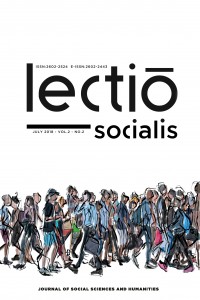Abstract
Economic
growth represents a quantitative increase in gross domestic product; but it is
necessary for long-term and continuous growth to become an important
developmental indicator. Turkey in line with development plans, has identified
potential economic growth rates; but these ratios have not been realized and
the growth has followed a rolling path over the years. This has hampered the
continuity of economic growth. Behind this situation, which is described as
volatility, many factors play an important role, especially the wage employment
structure of the country, social and military expenditures, institutional
characteristics. The aim of this study is to analyze the reasons behind
Turkey's volatile growth, to discuss how to ensure stable growth.
Keywords
References
- Artan, S. ve Hayaloğlu, P. (2014). Kurumsal Yapı ve İktisadi Büyüme İlişkisi: Türkiye Örneği, Sosyoekonomi 140216.
- Ateş, S. (2012). Türkiye İmalat Sanayinde Toplam Faktör Verimliliği ve Uzun Dönem Büyüme İlişkileri, Türkiye Ekonomi Kurulu Tartışma Metni 2012 (70)
- Barro, R. J. (1997). Getting it Right: Markets and Choices in a Free Society, The MIT press.
- Bilim, Sanayi ve Teknoloji Bakanlığı Verimlilik Genel Müdürlüğü, (2015). Verimlilik Stratejisi ve Eylem Planı, Ankara, Türkiye.
- Campbell, D. L., (2013). Relative Prices, Hysteresis, and the Decline of American Manufacturing. MPRA Paper 51723, University Library of Munich, Germany.
- Daron, A., Naidu, S., Restrepo, P. ve Robinson, J.A. (2014). Democracy Does Cause Growth. NBER Working Papers 20004, National Bureau of Economic Research, Inc.
- Freedom House (2018). Democracy in Crisis: Freedom in the World Report 2018
- Hall, R. E. ve Jones, C. I. (1999). Why Do Some Countries Produce So Much More Output Per Worker Than Others? The Quarterly Journal of Economics, 114 (1), 83-116
- Hisamoglu, E. (2014). EU membership, institutions and growth: The case of Turkey, Economic Modelling, Elsevier, vol. 38(C), 211-219.
- Kepenek, Y. (2016). Türkiye Ekonomisi, Remzi Kitapevi
- Koren, M. ve Tenreyro, S. (2007). Volatility and Development. The Quarterly Journal of Economics, 122, (1), 243-287
- Lucas, R. E. (1988). On The Mechanics of Economic Development, Journal of Monetary Economics 22, 3-42. North-Holland
- Mitchell, W. C. (1950). Backward Art of Spending Money and Other Essays, Reprints of Economic Classics, New York: A.M. Kelley.
- OECD Social Expenditure Database (2011). Is the European welfare state really more expensive? Indicators on social spending, 1980-2012 and a manual to the OECD (SOCX), Social, Employment and Migration Working Papers, 124
- Özerkek, Y. (2014). Türkiye’de Ücretli İstihdam ve Büyüme, Marmara Üniversitesi İ.İ.B. Dergisi, Cilt XXXVI (1), 215-227
- Stockholm International Peace Research Institute (2017). Armaments, Disarmament and International Security. Oxford University Press
Keywords
References
- Artan, S. ve Hayaloğlu, P. (2014). Kurumsal Yapı ve İktisadi Büyüme İlişkisi: Türkiye Örneği, Sosyoekonomi 140216.
- Ateş, S. (2012). Türkiye İmalat Sanayinde Toplam Faktör Verimliliği ve Uzun Dönem Büyüme İlişkileri, Türkiye Ekonomi Kurulu Tartışma Metni 2012 (70)
- Barro, R. J. (1997). Getting it Right: Markets and Choices in a Free Society, The MIT press.
- Bilim, Sanayi ve Teknoloji Bakanlığı Verimlilik Genel Müdürlüğü, (2015). Verimlilik Stratejisi ve Eylem Planı, Ankara, Türkiye.
- Campbell, D. L., (2013). Relative Prices, Hysteresis, and the Decline of American Manufacturing. MPRA Paper 51723, University Library of Munich, Germany.
- Daron, A., Naidu, S., Restrepo, P. ve Robinson, J.A. (2014). Democracy Does Cause Growth. NBER Working Papers 20004, National Bureau of Economic Research, Inc.
- Freedom House (2018). Democracy in Crisis: Freedom in the World Report 2018
- Hall, R. E. ve Jones, C. I. (1999). Why Do Some Countries Produce So Much More Output Per Worker Than Others? The Quarterly Journal of Economics, 114 (1), 83-116
- Hisamoglu, E. (2014). EU membership, institutions and growth: The case of Turkey, Economic Modelling, Elsevier, vol. 38(C), 211-219.
- Kepenek, Y. (2016). Türkiye Ekonomisi, Remzi Kitapevi
- Koren, M. ve Tenreyro, S. (2007). Volatility and Development. The Quarterly Journal of Economics, 122, (1), 243-287
- Lucas, R. E. (1988). On The Mechanics of Economic Development, Journal of Monetary Economics 22, 3-42. North-Holland
- Mitchell, W. C. (1950). Backward Art of Spending Money and Other Essays, Reprints of Economic Classics, New York: A.M. Kelley.
- OECD Social Expenditure Database (2011). Is the European welfare state really more expensive? Indicators on social spending, 1980-2012 and a manual to the OECD (SOCX), Social, Employment and Migration Working Papers, 124
- Özerkek, Y. (2014). Türkiye’de Ücretli İstihdam ve Büyüme, Marmara Üniversitesi İ.İ.B. Dergisi, Cilt XXXVI (1), 215-227
- Stockholm International Peace Research Institute (2017). Armaments, Disarmament and International Security. Oxford University Press
Details
| Primary Language | Turkish |
|---|---|
| Journal Section | Research Articles |
| Authors | |
| Publication Date | July 30, 2018 |
| Submission Date | March 23, 2018 |
| Acceptance Date | April 26, 2018 |
| Published in Issue | Year 2018 Volume: 2 Issue: 2 |
Lectio Socialis is a prestigious, international, and peer-reviewed journal that aims to provide a platform for scholars and researchers to share their work and ideas on policy-relevant topics related to social sciences. The journal welcomes high-quality articles from a wide range of disciplines, including economics, political science, public administration, business administration, international relations, urban planning, sociology, psychology, history, jurisprudence, and philosophy. The primary objective of Lectio Socialis is to maintain a vibrant, independent, and unbiased environment for scholars and researchers from different parts of the world to present their research, exchange ideas, and contribute to the advancement of knowledge in their respective fields.



